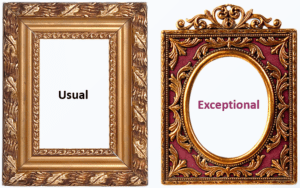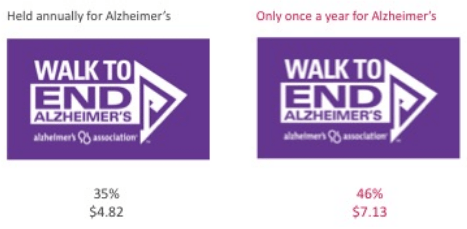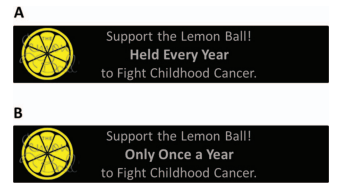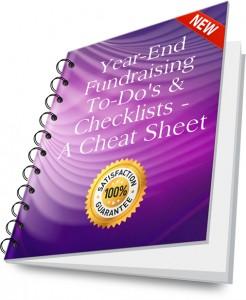
Think carefully about the frame in which you place your appeal
Are you framing your ask as an “annual appeal” or as “we only ask once a year?”
A growing body of research in psychology and behavioral economics shows how you frame your ask can have a big difference in your fundraising results.
Much of this has to do with how people mentally account for all consumer ‘purchases,’ including charitable giving.
Researchers have found people don’t treat all of their money (or time, effort or other resources) as if they have one big pool of it. Rather, they have separate mental accounts. When they spend resources they keep track of that expenditure based on the mental account it came from.
This has significant fundraising implications, so it’s important to delve further into this mental accounting principle.
The Idea behind Mental Accounting
These accounts are typically based on people’s goals.
Research by Richard Thaler in 1985 (he went on to win the Nobel Prize in Economics in 2017) surmised that keeping separate mental accounts is a way people exercise self-control. People keep track of different mental accounts, and try not to spend too much from one resource.
Value is seen as relative. If you spend $100 for dinner, you might not go out for dessert or music afterwards because you feel you’ve used up your ‘entertainment budget’ for the evening. However you might spend $50 on a new jacket, because that comes from your ‘clothing budget.’
Thaler’s researched followed upon that of Daniel Kahneman , who participated with Amos Tversky in groundbreaking research in the 1980’s showing people often track their spending by posting purchases to specific categories(Kahneman also went on to win the Nobel Prize in Economics in 2002). They too found differences in how these mental categories are formed and evaluated can influence subsequent spending decisions.
If two Nobel-winning economist agree, perhaps we in the social benefit sector should pay attention!
Charitable Expense Framing
A 2015 study in the Journal of Experimental Psychology (Sharma, Sussman & Alter) found that framing charitable expenses as exceptional occurrences, rather than regular ones, increased giving.
You see, if folks are budgeting for a recurring expense they tend to “book it” either by writing it down or taking note of it mentally. If it’s a one-time expense however, they tend to take less formal notice.
Exceptional expenses are perceived as unusual, infrequent and/or irregularly timed. It’s not just the frequency of the expenditure that may be perceived as exceptional; it can also be the amount for the given individual (which is why donors will make a major, one-time outright or deferred gift).
Per Sussman & Alter, people have difficulty placing exceptional expenses into budget categories at all. This likely explains how we account for vacation spending differently from the exact same spending when we’re at home. We’ll buy an expensive meal while traveling that we’d never buy on our home turf. We don’t consider it “dining money.” We consider it “free” money because we only do it once in a while.
So? The outcome of framing a gift ask as exceptional is you create a perception the donor has “free” money that’s available for a rare charitable expenditure!
Exceptional Framing Disrupts People’s Philanthropic Budgeting Process
In a good way.
Let’s look at a couple of different ways this can work.
PENNIES A DAY
Research by Gourville in 1998 suggested framing a single donation as $1/day vs. $365/year could increase giving. This framing mechanism caused folks to compare the $1/day cost with similar small expenses rather than the aggregate $356 cost with other larger expenses. This is the type of psychology at work when you ask folks to give $10/month rather than $120.
EXCEPTIONAL, NOT NORMAL
Research by Sharma, Sussman & Alter suggests framing a donation as extraordinary, rather than ordinary, prevents folks from registering the full magnitude of the expense and in turn positively influences their willingness to donate. This is the type of psychology at work when you ask folks to make a one-time gift rather than an annual one.
Exceptional Framing Enhances Charitable Behavior
In a good way.
Donors will consider the impact of a donation on their budget to a lesser degree when the donation is framed as exceptional, partly because they then don’t consider the consequence of similar donations recurring over time. Here’s what the researchers found:
EXPERIMENT-Alzheimer’s Walk: Two posters were used to advertise an upcoming Alzheimer’s Association walk. Each framed the frequency of this event slightly differently. Results were stunningly different.

Framing the walk as exceptional (“only once a year”), rather than recurring (“held annually”), increased response rate and average gift. Additionally, the exceptional framing made people think less about the effect the donation might have on their budgets.
EXPERIMENT-Lemonade Stand: Two mailers framed a lemonade stand sale to fight childhood cancer differently. One made it clear this fundraiser happened annually and participants would be asked for a donation every year going forward; the other noted it happened only once a year and they were being asked only for one donation.
 Participants were asked how much they’d consider the annual, recurring event ask as part of their budget, and alternately how much they’d consider the one-time event ask as part of their budget.
Participants were asked how much they’d consider the annual, recurring event ask as part of their budget, and alternately how much they’d consider the one-time event ask as part of their budget.
“Given that the donation occurs [every single year/only once a year], to what extent would you consider the effect of this donation on your budget?”
Participants in the exceptional condition (only once/year) reported being significantly more likely to donate to the charity than did those in the ordinary condition (every single year).
Exceptional Framing Likely Helps with Emergency Response and Rage Giving
In a good way.
Even those with a set-aside annual budget for philanthropy will give ‘above and beyond’ in response to an emergency or perceived threat. This accounts for the outpouring of support seen in the wake of hurricanes, earthquakes, wildfires and the like.
Most people don’t stop and think about their philanthropic budget in times like these. ‘Emergency response’ money comes from a different mental account, perhaps more akin to helping a sick neighbor in need. Or fixing a broken window or hole in the roof.
When something appears urgently needed, people don’t deliberate. They think fast, not slow; emotionally, not rationally (this happens to be the premise of Kahneman’s later work, Thinking, Fast and Slow). So framing an appeal as urgent is one way to influence a donor’s response to your call to action.
Of course, you don’t want to cry wolf. The urgency must be genuine.
CAVEAT: Exceptional Framing is Likely Easier with Prospects than Current Donors
Repeat donors tend to have a more concrete understanding of the regularity of a particular charity drive, so it’s likely more difficult to shift their perception of whether the donation is ordinary or exceptional. The research cited worked primarily with new donor prospects, however, so the jury is still out on this proposition.
In fact, research from Robert Cialdini shows one of the principles of influence and persuasion is “commitment and consistency.” There’s a body of research showing people are inclined to repeat past behaviors. I’ve long advised folks to remind donors of past giving because this acts as a decision-making shortcut.
I’m wondering if asking current supporters for their “annual” gift should consider Cialdini’s research, but truly “exceptional” appeals (e.g., Giving Days; Special Programs; Capital Campaigns; Endowment Gifts; Emergency Appeals) might follow the research on framing.
It would be a great thing to test!
Before you hit “send” on your next appeal, think carefully about the frame you’re putting it in. It matters.
Interested in More Year-End Fundraising Tips?

63 pages filled with year-end fundraising tips in this comprehensive Solution Kit
You’ll find plenty of tweaks to boost your results, in many cases quite significantly. I’ll bet you can find just one or two strategies that will improve your results, perhaps in ways you may not have imagined. The only way you lose is by not trying. Get my Year-End Fundraising Solution Kit. It’s filled with tips and checklists to assure you don’t miss a trick. Everything you need to assure you get, and keep, the most donations possible this year. Not satisfied? All Clairification products come with a 30-day, no-questions-asked money-back guarantee.




